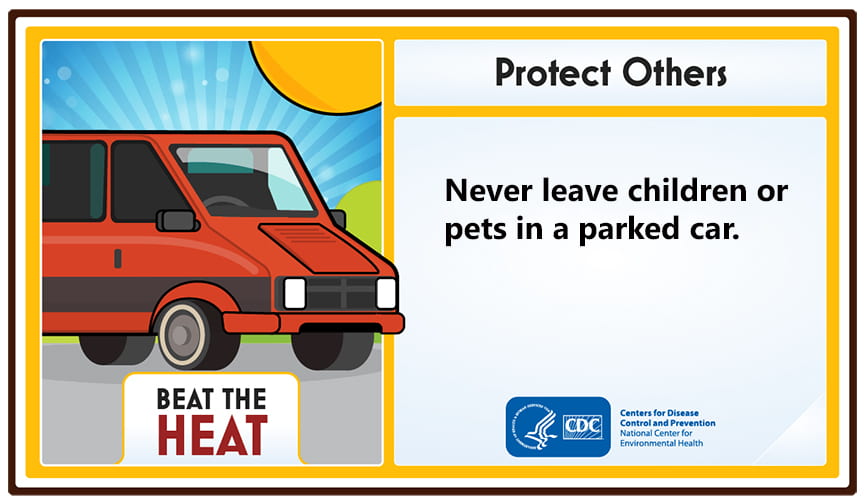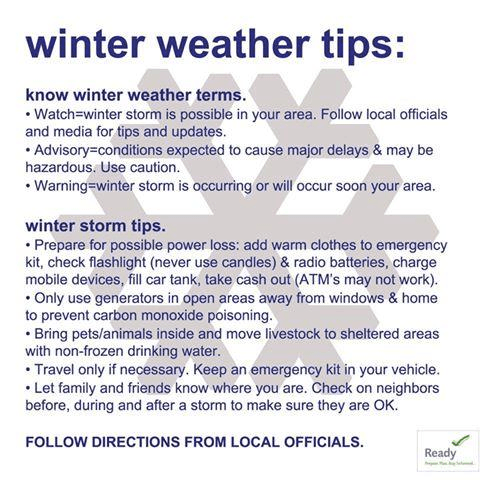Category: Weather-Ready
#FloodSafety– Know these #Wx Alert Terms
#Floods are the most common natural disaster in the U.S.
Timely info on weather conditions like a flood can make a big difference. Sign up for local alerts & warnings and review the following terms.
 A flood watch means “Be Aware” because conditions are right for flooding to occur in your area.
A flood watch means “Be Aware” because conditions are right for flooding to occur in your area.
A flood warning means “Take Action!” because flooding is either happening or will happen shortly.
A flash flood warning means flooding is occurring. Seek higher ground immediately. Listen to local officials.
Keep your communication ON when the power’s OFF with a hand-crank radio, solar or car phone charger and batteries.
#GetPrepared for #WinterSafety
When the calendar says it is still fall, but the weather says winter is on the way, learn how to stay safe before, during, & after winter storms & extreme cold with the tips below and by visiting: www.ready.gov/winter
Advisory, Watch, Warning? Understand these important terms!
September is National Preparedness Month. It is also our annual Prepare Kansas online challenge. Prepare Kansas 2017 will provide tips on getting financially prepared ahead of disasters and emergencies. This year’s program will be conducted through the K-State Research and Extension Facebook page. No registration is required, so Kansans and anyone interested in planning ahead for emergencies can follow on Facebook and this blog at any time during September, pick up handy information and interact with K-State extension specialists and agents. Today’s post is written by Mary Knapp, Climatologist and Associate Specialist Weather Data Library.
When we think of severe weather, it is important to understand the terms used. The National Weather Service uses three specific terms to indicate the severity of the event. Advisory means that hazardous weather is expected and likely to be an inconvenience, but not life threating if normal precautions are taken. It is often used with heat events, floods or winter weather. Watch means to WATCH for changing conditions. The National Weather Service may indicate that they are expecting to issue watches several days before the storm’s arrival allowing more time for preparations. Warning means that the severe event is actually occurring. Take action NOW.
In addition to the severity of the weather expected, the type of weather is also indicated. These include heat waves, dust, high winds, thunderstorms, floods, winter weather, blizzards, ice storms, and, of course tornadoes.
 What is meant by some severe weather events is usually self-explanatory. Here are some of the definitions for less easily understood events. A heat wave is defined as” A period of abnormally and uncomfortably hot and unusually humid weather.” Typically, a heat wave lasts two or more days. Thresholds temperatures for a heatwave vary by location and season. A severe thunderstorm, rather than a regular thunderstorm, is one that can produce a tornado, winds of at least 58 miles per hour and/or hail at least 1″ in diameter.
What is meant by some severe weather events is usually self-explanatory. Here are some of the definitions for less easily understood events. A heat wave is defined as” A period of abnormally and uncomfortably hot and unusually humid weather.” Typically, a heat wave lasts two or more days. Thresholds temperatures for a heatwave vary by location and season. A severe thunderstorm, rather than a regular thunderstorm, is one that can produce a tornado, winds of at least 58 miles per hour and/or hail at least 1″ in diameter.
A blizzard is a winter storm where the following severe conditions are expected to last 3 hours or longer: more sustained wind or frequent guest of at least 35 miles per hour, falling or blowing snow that reduces visibility to ¼ mile or less. Ice storm is used to describe times when damaging accumulations of ice are expected during freezing rain situations. Significant accumulations of ice pull down trees and utility lines resulting in loss of power and communication. These accumulations of ice make walking and driving extremely dangerous. Significant ice accumulations are usually accumulations of a quarter of an inch or greater.
Whatever the weather expected, preparation can reduce the risk to you and your family. Have an emergency plan and emergency kit available. Review that plan and refresh the kit on a regular basis. Monitor conditions more frequently if severe weather is in the forecast. And, take action when necessary.


